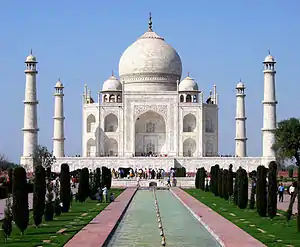Aram Bagh, Agra
The Aram Bagh is the oldest Mughal Garden in India, originally built by the Mughal Emperor Babur in 1528, located about five kilometers northeast of the Taj Mahal in Agra, India. Babur was temporarily buried there before being interred in Kabul.
| Aram Bagh, Agra | |
|---|---|

| |
| Type | Botanical garden |
| Location | India |
| Coordinates | 27°12′20.347″N 78°2′15.9″E |
.jpg.webp)
The garden is a Persian garden, where pathways and canals divide the garden to represent the Islamic ideal of paradise, an abundant garden through which rivers flow. The Aram Bagh provides an example of a variant of the charbagh in which water cascades down three terraces in a sequence of cascades. Two viewing pavilions face the Jumna river and incorporates a subterranean 'tahkhana' which was used during the hot summers to provide relief for visitors. The garden has numerous water courses and fountains.[1]
The name is a corruption of the Persian Aaram Bagh meaning 'Garden of Rest'.[2] It is also variously known as Bagh-i Nur Afshan 'Light-Scattering Garden', Aalsi Bagh or 'Lazy Garden': according to legend, Emperor Akbar proposed to his third wife, who was a gardener there, by lying idle for 6 days until she agreed to marry him.[1]
Jahangir waited in the garden in early March 1621 for the most astrologically auspicious hour for him to enter Agra after he took the Fort of Kangra. The preserved, surviving architecture dates to his reign and demonstrates the skill of his wife Nur Jahan as a garden designer.[1]
Citations
- Koch, p.37-41
- Meaning of Mughal Landscape
References
- Koch, Ebba. The Complete Taj Mahal: And the Riverfront Gardens of Agra (Hardback) (First ed.). Thames & Hudson Ltd. pp. 288 pages. ISBN 0-500-34209-1.
- Turner, Tom (1998). "Gardens guide - Aram Bagh". Gardenvisit.com. Archived from the original on 16 October 2006. Retrieved 14 March 2007.
- "Arambagh Gardens Agra". Agra hub. Archived from the original on 6 April 2007. Retrieved 14 March 2007.
Further reading
- Petruccioli, Attilio (ed.); Koch, Ebba (1997). "The Mughal Waterfront Garden. In Gardens in the Time of the Great Muslim Empires: Theory and Design". E. J. Brill. Retrieved 13 February 2007.CS1 maint: extra text: authors list (link)
